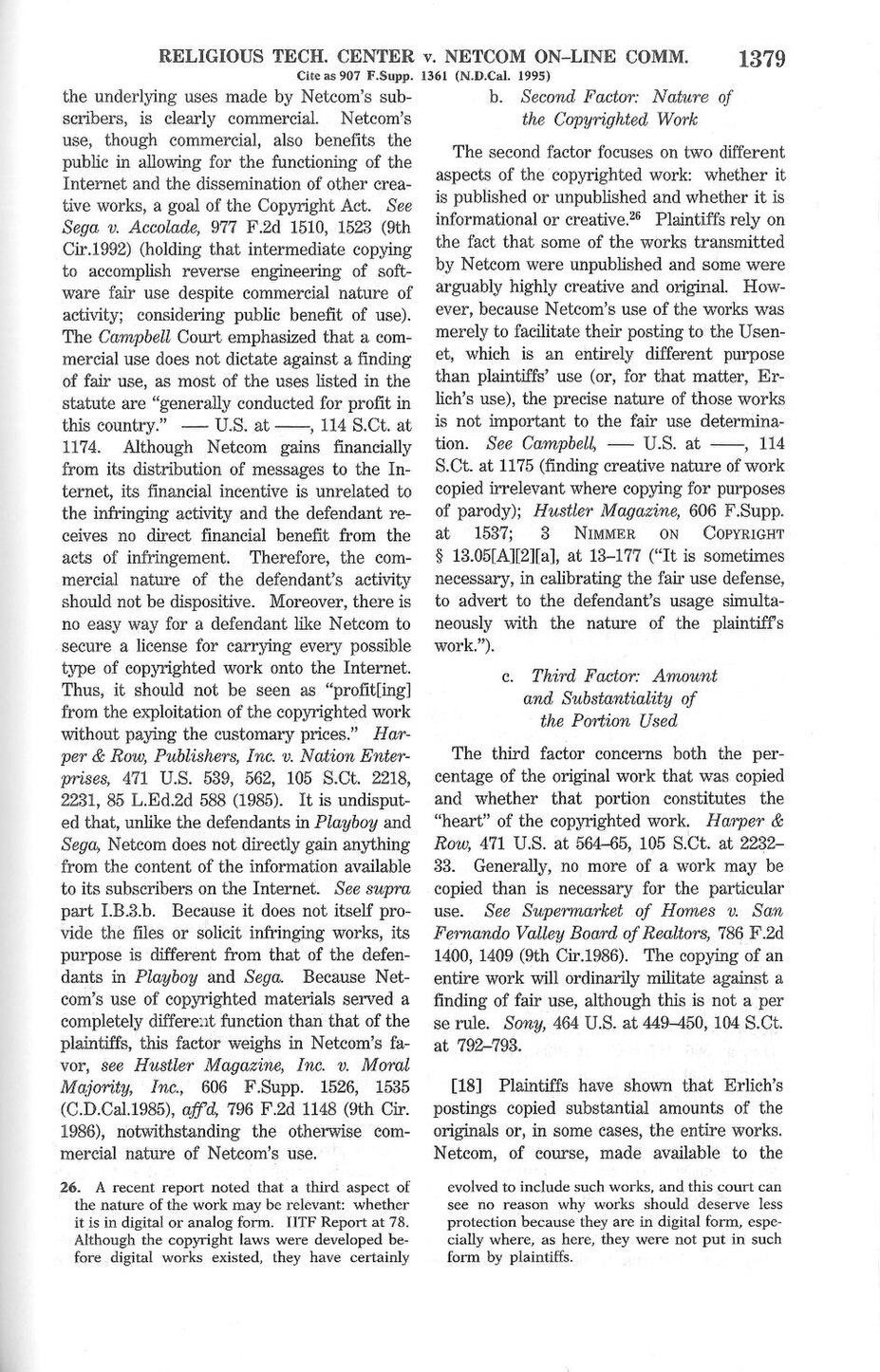Cite as 907 F.Supp. 1361 (N.D.Cal. 1995)
the underlying uses made by Netcom’s subscribers, is clearly commercial. Netcom’s use, though commercial, also benefits the public in allowing for the functioning of the Internet and the dissemination of other creative works, a goal of the Copyright Act. See Sega v. Accolade, 977 F.2d 1510, 1523 (9th Cir.1992) (holding that intermediate copying to accomplish reverse engineering of software fair use despite commercial nature of activity; considering public benefit of use). The Campbell Court emphasized that a commercial use does not dictate against a finding of fair use, as most of the uses listed in the statute are “generally conducted for profit in this country.” – U.S. at —, 114 S.Ct. at 1174. Although Netcom gains financially from its distribution of messages to the Internet, its financial incentive is unrelated to the infringing activity and the defendant receives no direct financial benefit from the acts of infringement. Therefore, the commercial nature of the defendant’s activity should not be dispositive. Moreover, there is no easy way for a defendant like Netcom to secure a license for carrying every possible type of copyrighted work onto the Internet. Thus, it should not be seen as “profit[ing] from the exploitation of the copyrighted work without paying the customary prices.” Harper & Row, Publishers, Inc. v. Nation Enterprises, 471 U.S. 539, 562, 105 S.Ct. 2218, 2231, 85 L.Ed.2d 588 (1985). It is undisputed that, unlike the defendants in Playboy and Sega, Netcom does not directly gain anything from the content of the information available to its subscribers on the Internet. See supra part I.B.3.b. Because it does not itself provide the files or solicit infringing works, its purpose is different from that of the defendants in Playboy and Sega. Because Netcom’s use of copyrighted materials served a completely different function than that of the plaintiffs, this factor weighs in Netcom’s favor, see Hustler Magazine, Inc. v. Moral Majority, Inc., 606 F.Supp. 1526, 1535 (C.D.Cal.1985), aff’d, 796 F.2d 1148 (9th Cir.1986), notwithstanding the otherwise commercial nature of Netcom’s use.
b. Second Factor: Nature of the Copyrighted Work
The second factor focuses on two different aspects of the copyrighted work: whether it is published or unpublished and whether it is informational or creative.[1] Plaintiffs rely on the fact that some of the works transmitted by Netcom were unpublished and some were arguably highly creative and original. However, because Netcom’s use of the works was merely to facilitate their posting to the Usenet, which is an entirely different purpose than plaintiffs’ use (or, for that matter, Erlich’s use), the precise nature of those works is not important to the fair use determination. See Campbell, – U.S. at —, 114 S.Ct. at 1175 (finding creative nature of work copied irrelevant where copying for purposes of parody); Hustler Magazine, 606 F.Supp. at 1537; 3 Nimmer on Copyright § 13.05[A][2][a], at 13-177 (“It is sometimes necessary, in calibrating the fair use defense, to advert to the defendant’s usage simultaneously with the nature of the plaintiff’s work.”).
e. Third Factor: Amount and Substantiality of the Portion Used
The third factor concerns both the percentage of the original work that was copied and whether that portion constitutes the “heart” of the copyrighted work. Harper & Row, 471 U.S. at 564–65, 105 S.Ct. at 2232–33. Generally, no more of a work may be copied than is necessary for the particular use. See Supermarket of Homes v. San Fernando Valley Board of Realtors, 786 F.2d 1400, 1409 (9th Cir.1986). The copying of an entire work will ordinarily militate against a finding of fair use, although this is not a per se rule. Sony, 464 U.S. at 449–450, 104 S.Ct. at 792–793.
Plaintiffs have shown that Erlich’s postings copied substantial amounts of the originals or, in some cases, the entire works. Netcom, of course, made available to the
- ↑ A recent report noted that a third aspect of the nature of the work may be relevant: whether it is in digital or analog form. IITF Report at 78. Although the copyright laws were developed before digital works existed, they have certainly evolved to include such works, and this court can see no reason why works should deserve less protection because they are in digital form, especially where, as here, they were not put in such form by plaintiffs.
